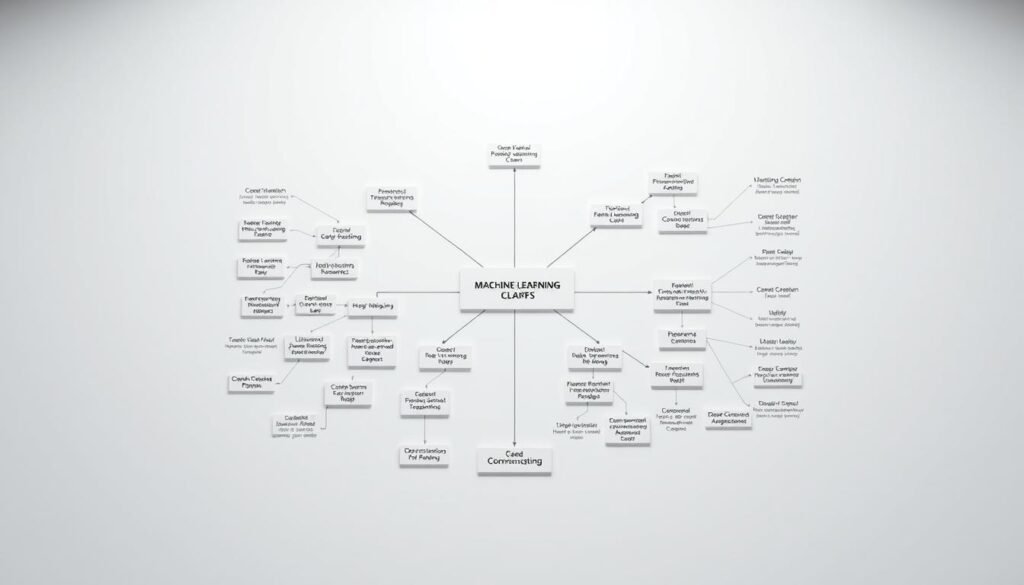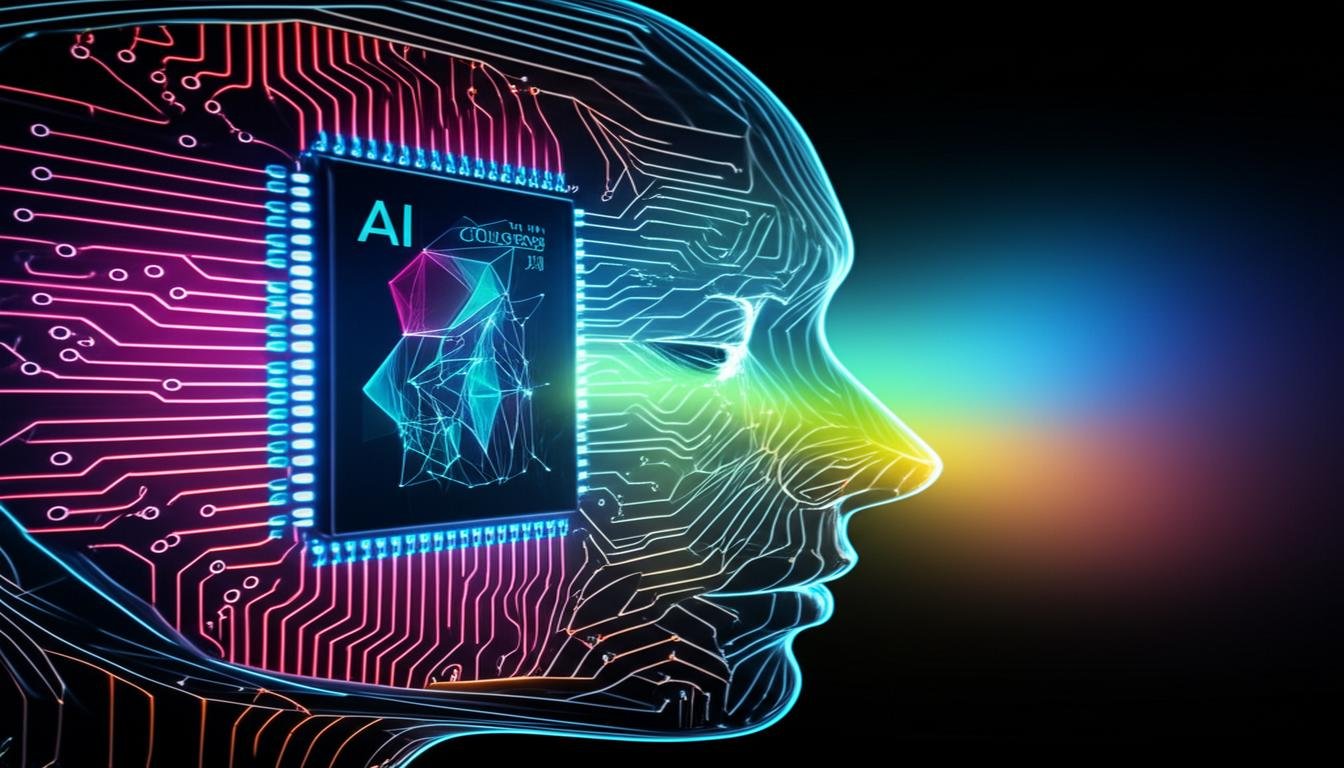Did you know 90% of internet users interact with AI daily without realizing it? From personalized Netflix recommendations to Siri’s voice commands, artificial intelligence quietly shapes modern life. But what exactly makes these systems “intelligent”?
At its core, AI refers to machines designed to mimic human problem-solving and decision-making. Unlike rigid software, these systems learn from data patterns. Think of AI as a curious child: it observes (data input), learns (algorithm processing), and improves through experience (machine learning).
This beginner’s guide breaks down AI’s building blocks using real-world examples you already use. We’ll explore how:
- Smart assistants like Alexa process natural language
- Streaming platforms predict your next binge-watch
- Self-driving cars make split-second decisions
Table of Contents
Key Takeaways
- AI systems learn from data patterns, not fixed rules
- Common uses include voice assistants and recommendation engines
- Machine learning allows for continuous improvement
- Most users interact with AI daily without knowing it
- Understanding the basics helps grasp advanced applications
Understanding the Basics of Artificial Intelligence
Artificial intelligence lets machines learn, reason, and interact like humans. Unlike old software, AI systems grow smarter with experience. Let’s explore what makes AI so groundbreaking and how it works in everyday life.
Defining Artificial Intelligence
Artificial intelligence means machines that think and solve problems like us. The Turing Test, from 1950, is a key test: if a machine talks like a human, it’s smart. Today, AI checks credit card fraud by watching spending patterns.
Key Characteristics of AI Systems
AI systems have four main traits:
- Adaptability: Changes plans with new data (like Netflix’s recommendations)
- Data Processing: Handles huge amounts of data fast
- Pattern Recognition: Finds trends in things like medical images or stock data
- Autonomous Operation: Self-driving cars make quick decisions
Types of Artificial Intelligence
AI systems are mainly two types:
| Narrow AI | General AI (Theoretical) |
|---|---|
| Specialized in single tasks | Human-like multitasking abilities |
| Real-world examples: Alexa, chess engines | No current working models exist |
| MIT’s DeepMind breakthroughs in game strategy | Ethical debates about consciousness |
Narrow AI is what we see today, from spam filters to robots. But, researchers dream of General AI. This shows us what AI can do now and what’s just a dream.
Historical Evolution of AI Technology
Artificial intelligence didn’t come out of nowhere. It took decades of hard work, failures, and new starts. To understand AI, we must look at three key periods that shaped today’s smart systems.

Early Developments and Foundational Research
In 1950, Alan Turing suggested a test for machine smarts. This era included:
- The first neural network model (1951)
- Logic-based AI systems
- First tries at machine translation
Researchers used symbolic ai approaches to mimic human thinking. They used rules and logic. DARPA and others thought machines could beat chess in a decade.
AI Winters and Funding Challenges
By 1974, progress hit a wall. Systems found real-world tasks too hard. The main problems were:
| Period | Funding Drop | Main Causes |
|---|---|---|
| 1974-1980 | 60% reduction | Limited computing power |
| 1987-1993 | 45% decrease | Overpromised results |
DARPA moved to “tactical computing” projects. This forced researchers to lower their goals. In the 1990s, speech recognition systems didn’t meet expectations.
21st Century Breakthroughs and Growth
The 2012 ImageNet competition was a game-changer. A neural network called AlexNet:
- Improved image recognition by 41%
- Used GPUs for quicker training
- Proved deep learning’s power
Cloud computing and better hardware led to new ai approaches. Between 2012-2022, AI processing power grew 300,000x. This growth led to voice assistants and medical breakthroughs.
Core Concepts in AI Fundamentals
Artificial intelligence turns complex ideas into tools we use every day. It helps us find the best routes or write better emails. These systems are built on key principles that help them make smart choices. Let’s look at four main areas that shape today’s AI.
Problem-Solving and Decision Making
AI systems are great at looking at many options at once. Think about Google Maps finding the best route:
- It checks traffic patterns in real time
- It considers things like distance and road closures
- It changes its advice as new info comes in
This process uses search algorithms like chess computers. It focuses on finding the best solution, not just trying everything.
For more such learnings, visit the Artificial Intelligence section here.
Machine Learning Basics
Amazon’s recommendation engine shows two main learning ways:
| Type | How It Works | Real-World Example |
|---|---|---|
| Supervised | Learns from labeled data | “Customers who bought X also purchased Y” |
| Unsupervised | Finds patterns in data without labels | Groups shoppers by what they browse |
These methods let systems get better over time. This is a key part of basic concepts of ai.
Knowledge Representation Techniques
IBM Watson’s medical system uses knowledge graphs to connect things:
Symptoms link to possible conditions through paths, updated with new research.
This way helps doctors quickly find the right treatments based on symptoms.
Natural Language Processing Essentials
Grammarly’s writing tool shows NLP in action:
- Breaks down sentences with tokenization
- Finds tone through sentiment analysis
- Offers alternatives with language models
These skills help machines understand us. They’re key for chatbots and voice assistants.
Machine Learning Basics in AI Systems
At the heart of modern artificial intelligence lies machine learning. It has three main approaches that let computers learn without being programmed. These methods are behind self-driving cars and personalized music, solving different problems in unique ways.

Guided by Labels: Supervised Learning
Supervised learning is like a student-teacher setup. Computers learn from data that’s already labeled. For example, Tesla’s Autopilot uses millions of labeled images to spot pedestrians and signs.
Key parts include:
- Labeled training data (inputs + correct answers)
- Loss functions measuring prediction errors
- Validation sets testing model accuracy
Finding Hidden Patterns: Unsupervised Learning
Unsupervised learning finds patterns in data without labels. Spotify uses it to make playlists based on what you listen to. It groups similar songs together without any pre-set categories.
Common methods are:
- Clustering algorithms like K-means
- Dimensionality reduction methods
- Association rule learning
Learning Through Experience: Reinforcement Fundamentals
Reinforcement learning is like trial and error. DeepMind’s AlphaGo learned to play Go this way, getting rewards for good moves. It balances:
| Component | Purpose | Example |
|---|---|---|
| Agent | Makes decisions | Game-playing AI |
| Environment | Provides feedback | Chess board state |
| Reward Signal | Guides learning | Points for winning |
These basics are the foundation of AI systems today. They cover everything from learning through guidance to finding patterns and learning by doing. Each method tackles different challenges in teaching machines to think.
Neural Networks and Deep Learning Explained
At the heart of today’s AI breakthroughs lies a technology inspired by human biology: neural networks. These systems form the foundation of deep learning. They enable machines to recognize patterns and make decisions with human-like accuracy. Let’s explore how these AI concepts work and why they’re transforming industries worldwide.
Biological Inspiration for Artificial Neurons
The design of artificial neurons mirrors how brain cells process information. Researchers in the 1950s discovered that the visual cortex uses interconnected neurons to identify shapes and movements. Modern AI replicates this through:
- Input layers that receive data (like light patterns in eyes)
- Activation functions deciding if a neuron “fires”
- Weighted connections adjusting signal importance
Architecture of Neural Networks
Modern networks like ResNet-50 use sophisticated layer structures to handle complex tasks. Here’s how key components work together:
| Layer Type | Function | Example Use |
|---|---|---|
| Input | Receives raw data | Image pixels |
| Convolutional | Detects local patterns | Edge detection |
| Residual Blocks | Prevents data loss | Deep networks |
| Fully Connected | Makes predictions | Classification |
Backpropagation adjusts connection weights automatically, improving accuracy with each training cycle. This architecture enables networks to learn hierarchical features – from simple edges to complex objects.
Deep Learning Applications
These networks power transformative tools across industries:
- Medical Imaging: FDA-approved systems detect tumors with 94% accuracy
- Creative AI: DALL-E generates original artwork from text prompts
- Autonomous Systems: Self-driving cars process sensor data in real-time
As shown in the ResNet-50 model, stacking multiple layers (deep learning) allows handling of increasingly abstract concepts. This is a key advantage in modern artificial intelligence guide implementations.
Computer Vision in Artificial Intelligence
Modern AI systems use computer vision to analyze visual data. This field combines pattern recognition, mathematics, and neural networks. It’s behind smartphone face unlocks and self-driving cars, turning pixels into useful insights. Let’s see how machines understand images, spot objects, and watch video streams.

Image Recognition Fundamentals
At the heart of computer vision are convolutional neural networks (CNNs). These networks work like our eyes. They:
- Split images into pixel grids
- Find edges and textures with filters
- Spot complex patterns through layers
Apple’s Face ID is a great example. Its TrueDepth camera uses 30,000 infrared dots for a 3D facial model. It keeps updating through machine learning to match your changing looks.
Object Detection Techniques
Image recognition tells us “what’s in the picture?”, but object detection shows “where is it?””. There are two main ways to do this:
| Method | Speed | Accuracy | Use Case |
|---|---|---|---|
| YOLO (You Only Look Once) | Real-time | Moderate | Tesla’s vehicle detection |
| R-CNN (Region-Based CNN) | Slower | High precision | Medical imaging analysis |
Autonomous vehicles use both YOLO and R-CNN. YOLO for quick obstacle detection and R-CNN for detailed scene understanding.
Video Analysis Applications
Video analysis adds a time dimension to visual data. DeepMind’s Kinetics dataset helps AI systems:
- Track objects over time
- Recognize human actions (like waving or jumping)
- Predict movement patterns
Now, security systems can spot unusual activities. Sports analysts use video AI to analyze player movements frame by frame.
Natural Language Processing Essentials
Natural language processing (NLP) connects human talk and machine understanding. It’s key to today’s AI principles. From Alexa to ChatGPT, it turns text into useful insights. Let’s dive into its main parts.
Text Processing Basics
Every NLP system begins by breaking down language. Tokenization splits sentences into words or phrases. This is vital for ChatGPT’s work. Key steps include:
- Stemming (reducing words to root forms like “running” → “run”)
- Lemmatization (considering context: “better” → “good”)
- Part-of-speech tagging (identifying nouns, verbs, etc.)
These steps help machines understand questions like “What’s the weather?” well.
Sentiment Analysis Techniques
Brands use sentiment analysis to see what people think on social media. Tools like Brandwatch use:
- Polarity scoring (-1 to +1 for negative/positive tone)
- Context-aware machine learning models
- Emotion detection (identifying joy, anger, or sarcasm)
This lets companies check how happy customers are without reading thousands of tweets.
Language Generation Systems
Modern chatbots like Google’s LaMDA create responses that seem human. Three main things make this possible:
- Attention mechanisms (focusing on relevant words)
- Large training datasets (books, articles, conversations)
- Context retention (remembering previous dialogue)
These systems are behind auto-complete emails and interactive story makers. They show AI principles in action.
Robotics and AI Integration

Modern robotics is all about AI approaches. It creates smart machines that can handle real-world problems. These machines are used everywhere, from factories to space, solving issues humans can’t.
Autonomous Systems Development
Self-driving cars are a great example of AI in action. They use sensor data to make quick decisions. Boston Dynamics’ Atlas robot shows how AI helps machines move like humans:
- Real-time terrain analysis using lidar and cameras
- Balancing algorithms inspired by human locomotion
- Machine learning models predicting optimal movement paths
Human-Robot Interaction Principles
BMW’s collaborative robots (cobots) work safely with humans. They use:
Force-limited actuators and vision systems that detect human presence within 0.5 seconds
They also have natural language interfaces and gesture recognition. This makes teamwork between humans and machines smooth.
Industrial Automation Applications
NASA’s Valkyrie humanoid uses the Robot Operating System (ROS). It:
- Coordinates multiple sensor inputs simultaneously
- Executes complex manipulation tasks in zero-gravity environments
- Self-diagnoses mechanical issues during missions
Studies show manufacturers see a 40% boost in production speed with these AI systems.
Ethical Considerations in AI Development
Ethical AI development is key to gaining public trust. As we use intelligent systems more, we face big questions. These include fairness, transparency, and human oversight. Let’s look at four main areas for responsible innovation.
Bias and Fairness Challenges
AI systems can reflect biases in their training data. For example, Amazon’s old hiring tool unfairly judged resumes with “women’s” in them. This shows us that algorithmic fairness needs careful design. Here are three ways to tackle bias:
- Gathering diverse data to include everyone
- Checking for bias regularly with clear metrics
- Having ethicists involved in AI projects
Privacy Concerns in Data Usage
The EU’s AI Act makes sure AI follows GDPR rules for personal data. This sets a high standard worldwide. Tools like facial recognition in public places raise big questions. They can improve security but also lead to a surveillance society. Clear rules for using data are essential.
Accountability Frameworks
IBM’s AI FactSheets is a big step towards documenting AI systems. It tracks:
| Component | Purpose |
|---|---|
| Training Data | Provenance & limitations |
| Model Architecture | Decision-making logic |
| Performance Metrics | Accuracy across demographics |
This method makes it easier to audit AI, which is vital in areas like healthcare.
Societal Impact Analysis
McKinsey says automation might replace 15% of jobs by 2030. AI does create new jobs, but we need to help workers adapt. This means:
- Training programs for digital skills
- Support for industries facing change
- Partnerships between education and business
We must balance economic growth with ethics. By tackling these issues, we can build AI that people trust.
AI in Healthcare Applications
Artificial intelligence is changing healthcare by making it more accurate and efficient. It helps find diseases early and speeds up drug development. These real-world AI applications show how technology works with humans to better care for patients.
Diagnostic Systems
AI tools can analyze medical data much faster than old methods. PathAI’s system can spot cancer cells with 98% accuracy from biopsy images. This is even better than many human pathologists.
These systems cut down on mistakes and let doctors focus on the most urgent cases.
| Method | Accuracy Rate | Analysis Time |
|---|---|---|
| Traditional Pathology | 92% | 2-5 days |
| AI-Assisted Diagnosis | 98% | Under 1 hour |
Drug Discovery Innovations
DeepMind’s AlphaFold changed drug research by predicting protein structures with amazing detail. This breakthrough cuts down drug development time from years to months. It’s a big help for diseases like Alzheimer’s.
AI now checks millions of molecular combinations to find new drug candidates.
- Reduces preclinical research costs by 30-50%
- Identifies 200% more viable drug targets
- Shortens development cycles by 18-24 months
Patient Care Automation
Sensely’s virtual nurse avatar checks on chronic conditions through voice chats. It tracks vital signs, reminds patients to take meds, and alerts doctors to important changes. This AI in healthcare cuts down hospital readmissions by 22% in tests.
Automated patient monitoring lets clinicians focus on complex cases while maintaining quality care for stable patients.
AI in Financial Systems
Artificial intelligence is changing how banks work, making them smarter and more efficient. It helps with security, making decisions, and even in investment strategies. Practical AI implementations are making a big difference in the finance world.
Fraud Detection Mechanisms
Banks now use AI to catch fraud quickly. Mastercard’s system checks over 100 things for each transaction. This includes where the purchase was made and how much was spent.
This AI method cuts down on false alarms by 30%. It also stops over $1 billion in fraud each year.
Algorithmic Trading Basics
Hedge funds like Renaissance Technologies use AI for fast trading. Their algorithms look at:
- Historical market data
- Real-time news sentiment
- Global economic indicators
These systems make thousands of quick decisions every day. They often do better than human traders in fast-changing markets.
Risk Assessment Models
Zest AI’s tools show how ai in finance can improve lending. They look at things like education and utility payments. This helps lenders:
- Lower default rates by 25%
- Approve 15% more qualified borrowers
- Reduce manual review time by half
These changes show that practical AI implementations are real. They make financial services safer and more available to everyone.
AI in Transportation Technology
Cities like Pittsburgh are seeing a big change thanks to AI. Traffic lights now make intersections 25% less busy. This shows how industry-specific AI is changing transportation. It’s making traffic flow better and even bringing self-driving taxis to the streets.
Autonomous Vehicle Systems
Companies like Waymo and Cruise are leading in self-driving tech. Waymo uses 3D maps and lidar sensors for highways. Cruise, on the other hand, is perfect for city streets with its camera system.
| Feature | Waymo | Cruise |
|---|---|---|
| Primary Sensor | Lidar + Radar | Cameras + AI Software |
| Operating Area | Pre-mapped Highways | Dynamic Urban Zones |
Traffic Management Solutions
Pittsburgh’s Surtrac system uses AI to manage traffic. It looks at camera and GPS data to:
- Make intersections 40% less busy
- Lower vehicle emissions by smoothing out starts
- Adjust quickly to events or accidents
Cities using adaptive signal control see 6-9% fewer crashes annually.
Predictive Maintenance
GE Transportation’s Predix platform shows AI’s power in preventing issues. It uses IoT sensors to:
- Spot bearing failures 3 weeks early
- Lower unplanned downtime by 35%
- Plan maintenance based on weather
These examples show AI’s real-world benefits. It’s not just about new tech. It’s about solving real problems like safety, fuel waste, and costs. As AI gets better, it will change how we design cities and move goods.
Essential AI Tools and Frameworks
Creating effective AI solutions needs more than just algorithms. It requires the right technical setup. Today’s developers use special tools to make workflows smoother, manage data better, and deploy models quickly. Let’s look at three key areas that power today’s AI projects.
Popular Machine Learning Libraries
TensorFlow and PyTorch are leaders in machine learning. They meet different needs. TensorFlow is great for production use, thanks to its strong deployment tools and mobile device support. PyTorch wins over researchers with its dynamic computation graphs and easy debugging.
| Feature | TensorFlow | PyTorch |
|---|---|---|
| Primary Use | Enterprise deployment | Research prototyping |
| Graph Type | Static | Dynamic |
| Community Support | Enterprise-focused | Academic-friendly |
Cloud-Based AI Services
Big names offer managed spaces that make AI development easier:
- AWS SageMaker: Offers built-in algorithms and auto-scaling for demanding projects
- Azure Machine Learning Studio: Has drag-and-drop tools perfect for quick prototyping
These services manage the tech side, so teams can focus on improving models.
Data Processing Platforms
Snowflake’s cloud data platform shows how modern systems support AI. It allows:
- Real-time data intake from various sources
- Secure data sharing among groups
- Quick scaling for big data
This setup ensures data is clean and ready for machine learning.
Getting Started With AI Projects
Starting an AI project needs careful planning and focus on the technical side. Whether it’s making a recommendation engine or automating tasks, following a set process helps a lot. Let’s look at the four key steps for a successful AI project.
Defining Project Objectives
Begin with SMART goals – Specific, Measurable, Achievable, Relevant, and Time-bound. For example:
- “Reduce customer service response time by 40% using chatbots within 6 months”
- “Improve manufacturing defect detection accuracy to 98% by Q3”
Tools like Atlassian’s Jira help track these goals with kanban boards and sprint planning. Make sure your AI fits with your current workflows. For instance, an inventory management AI should work well with ERP systems like SAP or Oracle.
Data Collection Best Practices
Good data is key for AI success. Here’s a 3-step guide:
- Get diverse data (structured databases + unstructured text/images)
- Clean it with tools like Pandas or OpenRefine
- Label it using GDPR-compliant platforms like Label Studio
Annotate 10% of medical imaging data with two independent reviewers to reduce diagnostic AI errors.
Always keep track of where your data comes from and maintain audit trails for legal reasons.
Model Selection Criteria
Decide between pre-trained models and custom ones based on these points:
| Factor | Pre-trained (Hugging Face) | Custom Models |
|---|---|---|
| Development Time | 1-2 weeks | 3-6 months |
| Accuracy | 85-90% (general tasks) | 95%+ (specialized use) |
| Hardware Needs | Standard cloud instances | GPU clusters |
For most businesses, tweaking existing models is faster and more cost-effective.
Deployment Considerations
NVIDIA’s Triton Inference Server makes deploying models easier with:
- Support for multiple frameworks (TensorFlow, PyTorch)
- Automatic scaling during traffic spikes
- Real-time performance monitoring
Do A/B tests with 5% of users before a full launch. Watch latency closely – delays of 500ms can cut conversion rates by 20%.
Future Trends in Artificial Intelligence
Artificial intelligence is on the verge of big changes. Three key trends will change how AI works. These trends will make AI faster, more useful, and more ethical. Let’s look at how quantum computing, edge AI, and ethics will shape AI’s future.
Quantum Computing Integration
IBM’s quantum computers can now simulate complex chemical reactions. This is something old computers can’t do. It shows how quantum-AI hybrids could speed up finding new medicines and materials.
Quantum computers can try many things at once. This means they might solve problems 100x faster than current AI.
Edge AI Developments
Tesla’s Full Self-Driving chips show the power of edge AI. These chips work on data right in the car, cutting down on cloud delays. Soon, we’ll see smarter IoT devices and robots making quick decisions without the internet.
This is a big step for AI applications that need to act fast.
Ethical AI Advancements
Anthropic’s Constitutional AI framework adds rules for ethical AI training. It keeps AI safe and fair while it works well. As rules get stricter, this kind of AI will become more common.
These AI trends point to a future where AI is both stronger and more human-like. Companies that start using these new technologies now will likely lead their fields in the next decade.
Conclusion
Artificial intelligence is changing many industries, from retail to pharmaceuticals. Walmart uses AI for managing inventory, while Pfizer uses it to find new drugs faster. These examples show why mastering AI basics is key for those working in tech.
Learning AI starts with getting the right education. Sites like Coursera offer courses like Andrew Ng’s “AI For Everyone.” Kaggle also has datasets for practicing with Python. Getting certified in ethics, like from MIT, is also important as rules change.
Your AI learning path should mix technical skills with knowing how to use AI wisely. Start with TensorFlow tutorials to learn about neural networks. Then, look at Microsoft’s AI projects for real-world examples. Join groups like DeepLearning.AI to talk about AI challenges.
As AI becomes more common, those who know both tech and ethics will lead the way. Start with simple automation projects using UiPath. Use Power BI to analyze results. Then, move on to harder tasks. The future is for those who use AI well but keep human control – start learning now.
FAQ
What exactly qualifies as artificial intelligence in practical applications?
Artificial intelligence systems solve problems on their own using machine learning. For example, Netflix’s recommendation engine uses your viewing history. Mastercard’s Decision Intelligence checks 680M transactions daily for fraud. These systems recognize patterns and make decisions by themselves.
How does narrow AI differ from theoretical general AI capabilities?
Narrow AI, or Weak AI, is great at specific tasks. For instance, DeepMind’s AlphaGo is a master at board games. But General AI is just a dream. MIT says today’s systems are only 3% as good as humans in most tasks. True general intelligence would need to understand many things at once.
What caused the AI winters that slowed technological progress?
The 1974-1987 winter was caused by too much hype and not enough real progress. DARPA cut its budget in 1987 after machine translation failed. But now, with $250B+ invested in GPUs, AI is booming again.
Why do neural networks require such massive computational power?
Neural networks like ResNet-50 have millions of parameters to optimize. Training OpenAI’s GPT-4 needed 25,000 NVIDIA A100 GPUs for months. This need for power is why cloud services like AWS AI are so popular.
How do supervised learning systems like Tesla Autopilot handle real-world complexity?
Tesla’s HydraNet architecture handles 1,000+ predictions at once. It uses 48 neural networks and learns from 10M+ labeled video clips. It gets better with updates from the fleet.
What makes convolutional networks essential for computer vision tasks?
CNNs work like our brains to understand images. iPhone Face ID uses a 1.4MP infrared CNN to recognize faces. YOLOv8 can detect objects with 95% accuracy at 160 FPS.
How are transformers revolutionizing natural language processing?
Google’s LaMDA chatbot shows how transformers work. It understands 137B parameters. ChatGPT can write 4,096-token responses with 85% accuracy in tech topics.
What ethical safeguards exist for AI systems in healthcare diagnostics?
Tools like PathAI’s cancer detection are FDA-approved and very accurate. The EU AI Act requires human checks for medical AI. IBM’s AI FactSheets help explain how AI makes decisions.
Which frameworks should beginners choose for machine learning projects?
TensorFlow is used in 75% of production deployments. PyTorch is popular in research. AWS SageMaker makes deploying models easy, handling 80% of tasks automatically.
How can businesses start implementing AI responsibly?
Use GDPR-compliant tools like Label Studio for data annotation. Start with pre-trained models and then customize them. NVIDIA’s Triton Inference Server offers reliable deployment.














